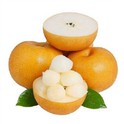Hey there! I'm a supplier of Wonhwang Pears, and let me tell you, keeping these delicious fruits pest - free is no walk in the park. But over the years, I've picked up some tips and tricks that I'm excited to share with you. So, let's dive right in and talk about how to prevent pests from attacking Wonhwang Pear trees.
Understanding the Enemy: Common Pests
First things first, you gotta know what you're up against. There are several pests that love to munch on Wonhwang Pear trees. One of the most common ones is the pear psylla. These tiny insects suck the sap from the leaves and shoots, which can lead to stunted growth and even death of the tree if left untreated. Another pesky critter is the codling moth. Its larvae bore into the fruit, making it inedible. And let's not forget about aphids. They cluster on the undersides of leaves, sucking out the plant's juices and causing the leaves to curl and yellow.
Cultural Practices for Pest Prevention
One of the best ways to keep pests at bay is through good cultural practices. Start with proper tree spacing. Wonhwang Pear trees need enough room to grow and breathe. If they're too crowded, it creates a perfect environment for pests and diseases to spread. Aim for a spacing of about 15 - 20 feet between each tree.
Pruning is also crucial. Regularly remove dead, diseased, or damaged branches. This not only improves the tree's overall health but also gets rid of potential hiding places for pests. Make sure to prune during the dormant season, usually in late winter or early spring.
Mulching around the base of the tree is another great idea. A layer of organic mulch, like wood chips or shredded leaves, helps retain moisture, regulate soil temperature, and suppress weeds. It also acts as a barrier, making it harder for pests to crawl up the trunk. Just be careful not to pile the mulch too high against the trunk, as this can cause rot.


Biological Control
Nature has its own way of keeping pests in check, and we can use that to our advantage. One of the most effective biological control methods is introducing beneficial insects. Ladybugs, for example, are great at eating aphids. You can buy ladybugs from a garden supply store and release them in your orchard. Lacewings are another beneficial insect that feeds on aphids, mites, and other small pests.
Birds can also be your allies. Put up birdhouses and bird feeders in your orchard to attract birds like chickadees and bluebirds. These birds love to eat insects, including the ones that attack Wonhwang Pear trees.
Chemical Control
Sometimes, despite our best efforts, pests can still get out of hand. That's when chemical control may be necessary. But before you reach for the pesticides, make sure you know what you're doing. Read the label carefully and follow all the instructions.
There are different types of pesticides available, including insecticides, fungicides, and miticides. For pear psylla, a neonicotinoid insecticide can be effective. However, be aware that these chemicals can also harm beneficial insects, so use them sparingly.
When applying pesticides, timing is everything. For example, if you're trying to control codling moths, you need to spray at the right time in the moth's life cycle. Usually, this means spraying when the eggs are hatching, which is typically a few weeks after the tree has finished blooming.
Monitoring and Early Detection
Regular monitoring is key to preventing pest infestations. Walk through your orchard at least once a week and check the leaves, branches, and fruit for signs of pests. Look for things like holes in the leaves, discolored spots, or the presence of insects themselves.
Set up sticky traps in your orchard. These traps are coated with a sticky substance that catches flying insects. By checking the traps regularly, you can get an idea of what pests are present and how many there are. This allows you to take action before the problem gets out of control.
Traps and Barriers
In addition to sticky traps, there are other types of traps and barriers that can help keep pests away. For example, you can use pheromone traps to catch male codling moths. These traps release a synthetic version of the female moth's pheromone, which attracts the males and traps them.
Tree trunk wraps can also be effective. These wraps are made of a material that prevents pests like caterpillars from crawling up the trunk and reaching the leaves and fruit. Just make sure to remove the wraps in the spring to prevent moisture buildup and damage to the bark.
Conclusion
Preventing pests from attacking Wonhwang Pear trees takes a combination of good cultural practices, biological control, chemical control, monitoring, and the use of traps and barriers. By following these tips, you can keep your orchard healthy and your Wonhwang Pears delicious.
If you're interested in purchasing our high - quality Wonhwang Pears, or our other varieties like the Shinseiki Pear and Nansui Pear, we also offer a beautiful Pear Gift Box that's perfect for any occasion. Don't hesitate to reach out for more information or to start a procurement discussion.
References
- "The Fruit Gardener's Bible" by Lewis Hill
- "Organic Gardening for Beginners" by Jane Smith
- Various extension service publications on fruit tree pest management






